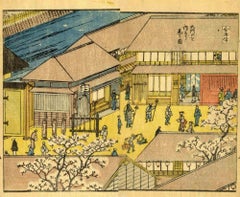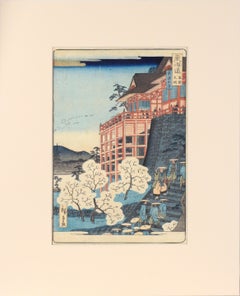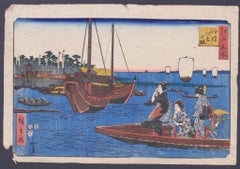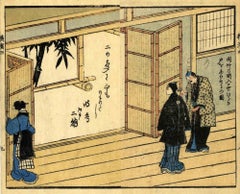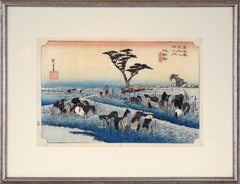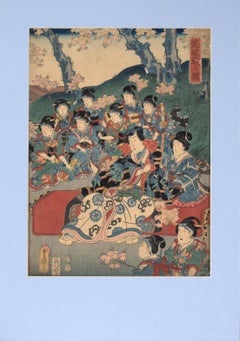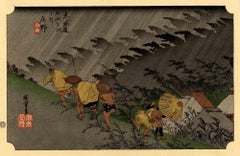Utagawa Hiroshige II Art
to
1
3
1
Overall Width
to
Overall Height
to
4
2
3
1
4
2
1
1
1
1
1
1
4
4
1
1
1
4
7,763
4,946
2,504
1,371
3
1
Artist: Utagawa Hiroshige II
Wandering Monks in the Courtyard of Konoura - Woodcut by U. Hiroshige II - 1840s
By Utagawa Hiroshige II
Located in Roma, IT
Wandering monks in the courtyard of Konoura is an original modern artwork realized by Utagawa Hiroshige II (1826 – 1869) in the 1840s.
Good impression with reduced palette mainly in...
Category
1840s Modern Utagawa Hiroshige II Art
Materials
Paper, Woodcut
Kiyomizu Temple, Scenes of Famous Places along Tôkaidô Road - Woodblock on Paper
By Utagawa Hiroshige II
Located in Soquel, CA
Kiyomizu Temple, Scenes of Famous Places along Tôkaidô Road - Woodblock on Paper
Full Title:
Kyoto: Kiyomizu Temple (Kyô Kiyomizudera), from the series Scenes of Famous Places along...
Category
1860s Edo Utagawa Hiroshige II Art
Materials
Ink, Rice Paper, Woodcut
Tsukuda Sumiyoshi no Yashiro - Woodcut by Hiroshige II - 1853
By Utagawa Hiroshige II
Located in Roma, IT
Tsukuda Sumiyoshi no yashiro (Sumiyoshi Shrine on Tsukuda Island) is the original title of this superb ten colour woodblock print on paper, by the Japanese master, Utagawa Hiroshige ...
Category
1850s Utagawa Hiroshige II Art
Materials
Woodcut, Paper
Bamboo Rooms in Iwahisa - Woodcut by Utagawa Hiroshige II - 1840s
By Utagawa Hiroshige II
Located in Roma, IT
Bamboo Rooms in Iwahisa is an original modern artwork realized by Utagawa Hiroshige II (1826 – 1869) in the 1840s.
Very good impression with reduced palette mainly in blue, green an...
Category
1840s Modern Utagawa Hiroshige II Art
Materials
Paper, Woodcut
Related Items
"Early Summer Horse Fair" from 53 Stations of the Tokaido
By Utagawa Hiroshige (Ando Hiroshige)
Located in Soquel, CA
"Early Summer Horse Fair" from 53 Stations of the Tokaido
Woodblock print of a group of horses, originally by Hiroshige (Ando) Utagawa (Japanese, 1797 - 1858). Several groups of hor...
Category
1830s Edo Utagawa Hiroshige II Art
Materials
Rice Paper, Woodcut
Dueling with Cherry Blossoms - Tales of Genji - Japanese Woodblock
By Utagawa Kunisada (Toyokuni III)
Located in Soquel, CA
Dueling with Cherry Blossoms - Tales of Genji - Japanese Woodblock
Rightmost panel a triptych, depicting a group of children and a samurai watching a "duel" with cherry blossoms. Th...
Category
1850s Realist Utagawa Hiroshige II Art
Materials
Printer's Ink, Rice Paper, Woodcut
Pine Trees at Maiko Beach, from "Sixty-odd Famous places of Japan"
By Utagawa Hiroshige (Ando Hiroshige)
Located in Soquel, CA
Pine Trees at Maiko Beach, from "Sixty-odd Famous places of Japan"
Woodblock print of pine trees along the shore, originally by Hiroshige (Ando) Utagawa (Japanese, 1797 - 1858). Pine trees follow the the curve of the shore, receding into the distant forest. In the midground, there are a few buildings with people nearby.
The original woodcut was created circa 1853. The is a later printing, re-carved, from the mid 20th Century.
Frame size: 21.5"H x 16.5"W
Image size: 14"H x 9.5"W
Born in Edo as Tokutaro Ando, Hiroshige Utagawa grew up in a minor samurai family. His father belonged to the firefighting force assigned to Edo Castle. It is here that Hiroshige was given his first exposure to art: legend has it that a fellow fireman tutored him in the Kano school of painting, though Hiroshige’s first official teacher was Rinsai. Though Hiroshige tried to join Toyokuni Utagawa's studio, he was turned away. In 1811, young Hiroshige entered an apprenticeship with the celebrated Toyohiro Utagawa. After only a year, he was bestowed with the artist name Hiroshige. He soon gave up his role in the fire department to focus entirely on painting and print design. During this time he studied painting, intrigued by the Shijo school. Hiroshige’s artistic genius went largely unnoticed until 1832.
In Hiroshige Utagawa's groundbreaking series of Japanese woodblock prints, The 53 Stations of the Tokaido (1832-1833), he captured the journey along the Tokaido road, the highway connecting Edo to Kyoto, the imperial capital. With the Tokugawa Shogunate relaxing centuries of age-old restrictions on travel, urban populations embraced travel art and Hiroshige Utagawa became one of the most prominent and successful ukiyo-e artists. He also produced kacho-e (bird-and-flower pictures) to enormous success. In 1858, at the age of 61, he passed away as a result of the Edo cholera epidemic.
Hiroshige Utagawa’s woodblock prints continue to convey the beauty of Japan and provide insight into the everyday life of its citizens during the Edo period. The appeal of his tender, lyrical landscapes was not restricted to the Japanese audience. Hiroshige’s work had a profound influence on the Impressionists and Post-Impressionists of Europe: Toulouse-Lautrec was fascinated with Hiroshige’s daring diagonal compositions and inventive use of perspective, while Van Gogh literally copied two of Hiroshige's prints from the famous series, 100 Famous Views of Edo...
Category
1850s Realist Utagawa Hiroshige II Art
Materials
Woodcut, Rice Paper, Ink
H 21.5 in W 16.5 in D 0.75 in
3 Jewish Men Judaica Woodblock Woodcut Engraving Print Chicago 1930s WPA Artist
By Todros Geller
Located in Surfside, FL
Todros Geller (1889 – 1949) was a Jewish American artist and teacher best known as a master printmaker and a leading artist among Chicago’s art community.Geller was born in Vinnytsia, the Russian Empire (now Ukraine) in 1889.[2] He studied art in Odessa and continued his studies after moving to Montreal in 1906 where he immigrated to Canada. He married and moved to Chicago in 1918, where he studied at the School of the Art Institute of Chicago until 1923.
Geller produced paintings, woodcuts, woodcarvings, and etchings. His work focused on Jewish tradition, often including moralistic themes and social commentary, shtetl, ghetto life, and the intersection of Jewish tradition with modern-day Chicago. He regarded art as a tool for social reform and he spent a large part of his career teaching art. His work was commissioned for stained glass windows, bookplates, community centers and Yiddish and English books. He was regarded as a leader in the field of synagogue and religious art. He designed stained glass window for synagogues in Omaha, Fort Worth, Dayton, Stamford, and Chicago Heights. Over the course of his career he illustrated more than 40 books.
In addition to conducting classes in his studio, Geller was head of art at the Jewish People’s Institute (JPI), supervisor of art for the Board of Jewish Education and director of art for the College of Jewish Studies (which became the Spertus Institute for Jewish Learning and Leadership) and taught at Hull House. Many prominent Chicago artists studied drawing and painting under Geller. Geller was a source of inspiration to Aaron Bohrod and Mitchell Siporin...
Category
Early 20th Century Modern Utagawa Hiroshige II Art
Materials
Paper, Woodcut
"Grave of Santa Anna's Leg" Original Woodblock Print, Signed Artist's Proof
By Carol Summers
Located in Soquel, CA
"Grave of Santa Anna's Leg" Original Woodblock Print, Signed Artist's Proof
Boldly colored woodblock print by Carol Summers (American, 1925-2016). This piece is a segment of a grave, with a headstone that has a skull and cross. There are two bright green plants flanking the headstone. Below the headstone and plants, there is a large arched blue shape, with a crescent moon and stars. A red leg, bent at the knee, cuts across the blue arch.
Signed "Carol Summers" along the right edge of the blue shape.
Numbered and titled "A/P Grave of Sant Anna's Leg" along the left edge of the blue shape.
Presented in a silver colored aluminum frame.
Frame size: 32.245"H x 27.25"W
Paper size: 29.75"H x 24.5"W
Carol Summers (1925-2016) has worked as an artist throughout the second half of the 20th century and into the first years of the next, outliving most of his mid-century modernist peers. Initially trained as a painter, Summers was drawn to color woodcuts around 1950 and it became his specialty thereafter. Over the years he has developed a process and style that is both innovative and readily recognizable. His art is known for it’s large scale, saturated fields of bold color, semi-abstract treatment of landscapes from around the world and a luminescent quality achieved through a printmaking process he invented.
In a career that has extended over half a century, Summers has hand-pulled approximately 245 woodcuts in editions that have typically run from 25 to 100 in number. His talent was both inherited and learned. Born in 1925 in Kingston, a small town in upstate New York, Summers was raised in nearby Woodstock with his older sister, Mary. His parents were both artists who had met in art school in St. Louis. During the Great Depression, when Carol was growing up, his father supported the family as a medical illustrator until he could return to painting. His mother was a watercolorist and also quite knowledgeable about the different kinds of papers used for various kinds of painting. Many years later, Summers would paint or print on thinly textured paper originally collected by his mother.
From 1948 to 1951, Carol Summers trained in the classical fine and studio arts at Bard College and at the Art Students League of New York. He studied painting with Steven Hirsh and printmaking with Louis Schanker. He admired the shapes and colors favored by early modernists Paul Klee (Sw: 1879-1940) and Matt Phillips (Am: b.1927- ). After graduating, Summers quit working as a part-time carpenter and cabinetmaker (which had supported his schooling and living expenses) to focus fulltime on art. That same year, an early abstract, Bridge No. 1 was selected for a Purchase Prize in a competition sponsored by the Brooklyn Museum.
In 1952, his work (Cathedral, Construction and Icarus) was shown the first time at the Museum of Modern Art in New York City in an exhibition of American woodcuts...
Category
1980s Contemporary Utagawa Hiroshige II Art
Materials
Ink, Handmade Paper, Woodcut
H 32.25 in W 27.25 in D 1 in
Chicago Skyline
By Paul Schumann
Located in Middletown, NY
A beautiful turn-of-the-century lake view of Chicago by an American artist known for his Texas landscapes.
Etching with drypoint on watermarked Umbria laid paper with deckle edges, 7 1/4 x 10 7/8 inches (182 x 275 mm), full margins. Signed and numbered 4/25 in pencil, lower margin. In good condition with adhesive residue at the sheet edges on the verso, does not show through to the recto. A lovely Lake Michigan landscape...
Category
Early 20th Century American Modern Utagawa Hiroshige II Art
Materials
Handmade Paper, Etching, Drypoint
3 Turns - Surfing Art - Figurative Print - Woodcut Print By Marc Zimmerman
By Marc Zimmerman
Located in Carmel, CA
Three surfers carving up the Hawaiian waves, having a blast in the tropical surf.
3 Turns - Surfing Art - Figurative Print - Woodcut Print By Marc Zimmerman
Limited Edition 01/05
...
Category
2010s American Modern Utagawa Hiroshige II Art
Materials
Woodcut
Christ and the Woman of Samaria Among Ruins by James Bretherton after Rembrandt
By Rembrandt van Rijn
Located in Middletown, NY
Bretherton, James (After Rembrandt van Rijn).
Christ and the Woman of Samaria Among Ruins.
London: c 1775.
Etching on light cream laid paper, 4 3/4...
Category
18th Century Old Masters Utagawa Hiroshige II Art
Materials
Handmade Paper, Etching, Laid Paper
THE RUG WEAVER
By Gustave Baumann
Located in Santa Monica, CA
GUSTAVE BAUMANN (1881 – 1971)
THE RUG WEAVER, 1910 (Chamberlain 26)
Color woodcut signed in pencil. Unnumbed from an edition 100 as published in the Hills o’ Brown...
Category
1910s American Modern Utagawa Hiroshige II Art
Materials
Woodcut
Shin-machi Bridge at Hodogaya - Japanese Woodcut Print on Rice Paper
By Utagawa Hiroshige
Located in Soquel, CA
Shin-machi Bridge at Hodogaya - Japanese Woodcut Print on Rice Paper
Woodblock print of travelers on a bridge by Utagawa Hiroshige (Japanese, 1797-185...
Category
1850s Impressionist Utagawa Hiroshige II Art
Materials
Rice Paper, Woodcut
H 15.5 in W 19.25 in D 1.25 in
Kiyomi Barrier & Seiken Temple Near Okitsu- Japanese Woodcut Print on Rice Paper
By Utagawa Hiroshige
Located in Soquel, CA
Kiyomi Barrier & Seiken Temple Near Okitsu - Japanese Woodcut Print on Rice Paper
Woodblock print of boats in a harbor by Utagawa Hiroshige (Japanese, 1797-1858). Originally publish...
Category
1850s Impressionist Utagawa Hiroshige II Art
Materials
Rice Paper, Woodcut
H 15.5 in W 19.25 in D 1.25 in
EARLY JACOULET - A DOWNPOUR AT METALANIM PONOPE EAST CAROLINAS
By Paul Jacoulet
Located in Santa Monica, CA
EARLY JACOULET
PAUL JACOULET (1896 – 1960)
UNE AVERSEA METALANIM, PONAPE , EST CAROLINES, 1935
A DOWNPOUR AT METALANIM PONOPE EAT CAROLINAS (Miles 29)
Color woodcut, with metallic ...
Category
1930s Modern Utagawa Hiroshige II Art
Materials
Color, Woodcut
Previously Available Items
Dragon Room in Iwahisa - Original Woodcut by Utagawa Hiroshige II - 1840s
By Utagawa Hiroshige II
Located in Roma, IT
Dragon Room in Iwahisa is an original modern artwork realized by Utagawa Hiroshige II (1826 – 1869) in the 1840s.
Good impression with reduced palette mainly in blue, green and yell...
Category
1840s Modern Utagawa Hiroshige II Art
Materials
Paper, Woodcut
Utagawa Hiroshige IIDragon Room in Iwahisa - Original Woodcut by Utagawa Hiroshige II - 1840s, 1840s
H 7.88 in W 11.82 in D 0.04 in
Meishoe - Original Woodcut by Utagawa Hiroshige II - 1830s
By Utagawa Hiroshige II
Located in Roma, IT
Meishoe is an original modern artwork realized by Utagawa Hiroshige II (1826 – 1869) in the 1830s..
Oban Yoko-e.
From the famous Tokaido series of 1833, the most famous print of th...
Category
1830s Modern Utagawa Hiroshige II Art
Materials
Paper, Woodcut
H 10.01 in W 14.97 in D 0.04 in
Catching Fireflies by the Uji River in Yamashiro Province
By Utagawa Hiroshige II
Located in Fairlawn, OH
Hiroshige ga, Toyokuni ga in toshidama cartouche;
Censor's seal: Chicken 8 aratame;
Blockcutter's mark: Horikô Mino, center sheet only, (Japanese, 1833-1906)
and Utagawa Ku...
Category
Mid-19th Century Utagawa Hiroshige II Art
Materials
Woodcut
Utagawa Hiroshige Ii art for sale on 1stDibs.
Find a wide variety of authentic Utagawa Hiroshige II art available for sale on 1stDibs. You can also browse by medium to find art by Utagawa Hiroshige II in paper, woodcut print and more. Much of the original work by this artist or collective was created during the 19th century and is mostly associated with the modern style. Not every interior allows for large Utagawa Hiroshige II art, so small editions measuring 9 inches across are available. Customers who are interested in this artist might also find the work of Utagawa Yoshitora, Keisei Eisen, and Kaoru Kawano. Utagawa Hiroshige II art prices can differ depending upon medium, time period and other attributes. On 1stDibs, the price for these items starts at $334 and tops out at $1,563, while the average work can sell for $718.
